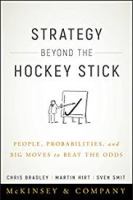 Strategy Beyond the Hockey Stick: People, Probabilities, and Big Moves to Beat the Odds
Strategy Beyond the Hockey Stick: People, Probabilities, and Big Moves to Beat the Odds
Chris Bradley, Martin Hirt, and Sven Smit
John Wiley & Sons (February 13, 2018)
What really matters — and what does not — for exceptional performance
When I first saw the title, I immediately assumed that the Chris Bradley, Martin Hirt, and Sven Smit would discuss a widely quoted observation by Wayne Gretsky who, when asked to explain his success, suggested that everyone knows where the puck is; he knew where it was going to be. A brilliant insight. Turns out, however, that I was wrong. The title refers to what the co-authors characterize as “the icon of the strategy process,” one that confidently illustrates “future success after the all-too-familiar dip in next year’s earnings.”
As the co-authors explain in the Introduction, rather than “relying on the traditional approach [to improving the strategy process] of best practices and inspiring anecdotes, we use broad and deep empirical research.” Many years ago, Peter Drucker said that “culture eats strategy for breakfast.” I agree, as do Bradley, Hirt, and Smit that the strategy process has a social dimension that is too often ignored or under-appreciated when business leaders attempt to have “real conversations about the future of [their] business and the tough choices [they must] make.”
The traditional assumption is that, if those involved in building a strategy are guided and informed by an “inside view” — limited to the data from their own industry, the perspective of their company, and the experiences of their own team members — the desired results will be achieved.
In fact, with rare exception, they aren’t. Why? Because strategy formulation needs an “outside view” based on data from “thousands of other other experiences by other executives and their companies in other strategy rooms” that have been brought into the process. Bradley, Hirt, and Smit wrote this book in order to provide those who read it with a comprehensive database of strategic success and failure that has not existed “until now.”
Their research examined “publicly available information on dozens of variables for thousands of companies and found a manageable number of levers — 10, in fact — that explain over 80 percent of up-draft and down-drift in corporate performance.” A strategy “beyond the hockey stick” must be developed in the realm of actual behavior rather than — as so often is the case — in the realm of what is theoretical and anecdotal.
Bradley, Hirt, and Smit urge their reader to (1) embrace the social side of strategy and (2) be prepared to open the windows of their strategy process to a data-driven, outside view to play a central role in the discussion and collaboration.
These are among the subjects discussed in the book that are of the greatest interest to me:
o All-time biases in strategy rooms (e.g. the halo effect)
o Self-serving attitudes and initiatives (e.g. sandbagging)
o Opening the windows of of strategy discussion (e.g. the Power Curve)
o Variation in economic profit within industries
o The “hairy back of reality”
o Bold forecasts
o Real hockey sticks
o The knowledgeable probability of success
o The 10 variables that make the difference
o The mobility dashboard
o Change your industry or change industries (i.e. “What business should you be in?”)
o The four stages of a disruptive trend
o Making the right Big Moves
o Differentiate improvement
o Eight shifts to unlock strategy
Obviously, no brief commentary such as mine can possibly do full justice to the quality and value of the information, insights, and counsel that Chris Bradley, Martin Hirt, and Sven Smit provide in this book. However, I hope I have at least indicated why I think so highly of them and their work. Theír concluding remarks correctly indicate that all windows — and minds — in the strategy room should be open:
“Strategy remains part science, part art — but with the underlying research of this book, we now have the understanding and the tools to effectively address some of the perennial conundrums around mobilizing management teams and companies. If you embrace the ides of probability, and internalize the ideas of this book about strategy to beat the odds, you might find your own way of overcoming human biases and addressing the social side of strategy. We are confident that, if you do, you will have a better shot at beating the market and creating value for your stakeholders.”
In Leading Change, James O’Toole suggests that the strongest resistance to change initiatives tends to be cultural in nature, the result of what he so aptly characterizes as “the ideology of comfort and the tyranny of custom.” That’s an important point to keep in mind.
Here’s another: What works for other companies may not work for yours…and what doesn’t work for other companies may well work for yours. If you know what business you should be in and who your customer should be, it really doesn’t matter what your strategy is…or isn’t.
Those hickey sticks will get you every time.
You got taht wright.